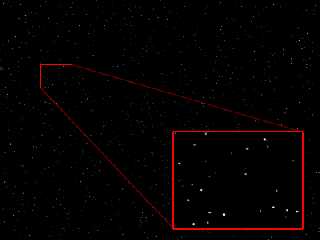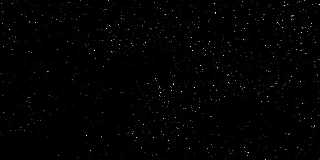 |
 |
|
 |
|
 |
|  |
|  |
|
 |
|
 |
|  |
|  |
|
 |
I know you've probably already seen a million or so like this, but I've
made a procedural starfield using a crackle pattern which I think looks
pretty convincing, or at least a lot better than my previously used
modified granite pattern from textures.inc. It was actually really simple
to make and it's the first time I've found crackle forms useful. It's a
hell of a lot simpler than a sphere-placing macro and I think the results
are better. Here's the code:
sphere {
0, 1
pigment {
crackle form <1, 1, 0>
scale 1/200
colour_map {
[0.4 rgb 1]
[0.6 rgb 0]
}
}
finish {
diffuse 0
ambient 1
}
inverse
scale 1000000
}
--
light_source#macro G(E)sphere{z+E*y*5e-3.04rotate-z*E*6pigment{rgbt#end{
20*y-10#local n=162;1}#while(n)#local n=n-.3;G(n)x}}G(-n).7}}#end//GregE
Post a reply to this message
Attachments:
Download 'starfield_proc.png' (19 KB)
Preview of image 'starfield_proc.png'

|
 |
|  |
|  |
|
 |
|
 |
|  |
|  |
|
 |
I hate to dissapoint you, but it's nothing new. I use this technique for at
least a year now :)
cu!
--
camera{location-z*3}#macro G(b,e)b+(e-b)*(C/50)#end#macro L(b,e,k,l)#local
C=0
;#while(C<50)sphere{G(b,e),.1pigment{rgb G(k,l)}finish{ambient 1}}#local
C=C+1
;#end#end
L(y-x,y,x,x+y)L(y,-x-y,x+y,y)L(-x-y,-y,y,y+z)L(-y,y,y+z,x+y)L(0,x+y,
<.5,1,.5>,x)L(0,x-y,<.5,1,.5>,x) // ZK
http://www.povplace.be.tf
Post a reply to this message
|
 |
|  |
|  |
|
 |
|
 |
|  |
|  |
|
 |
hmm, need to fix my width...
let's try this
cu!
--
camera{location-z*3}#macro G(b,e)b+(e-b)*(C/50)#end#macro L(b,e,k,l)#local C=0
;#while(C<50)sphere{G(b,e),.1pigment{rgb G(k,l)}finish{ambient 1}}#local C=C+1
;#end#end L(y-x,y,x,x+y)L(y,-x-y,x+y,y)L(-x-y,-y,y,y+z)L(-y,y,y+z,x+y)L(0,x+y,
<.5,1,.5>,x)L(0,x-y,<.5,1,.5>,x) // ZK http://www.povplace.be.tf
Post a reply to this message
|
 |
|  |
|  |
|
 |
|
 |
|  |
|  |
|
 |
Greg Edwards wrote:
> I know you've probably already seen a million or so like this, but I've
> made a procedural starfield using a crackle pattern which I think looks
> pretty convincing, or at least a lot better than my previously used
> modified granite pattern from textures.inc. It was actually really simple
> to make and it's the first time I've found crackle forms useful. It's a
> hell of a lot simpler than a sphere-placing macro and I think the results
> are better. Here's the code:
>
> sphere {
> 0, 1
> pigment {
> crackle form <1, 1, 0>
> scale 1/200
> colour_map {
> [0.4 rgb 1]
> [0.6 rgb 0]
> }
> }
> finish {
> diffuse 0
> ambient 1
> }
> inverse
> scale 1000000
> }
>
>
>
> ------------------------------------------------------------------------
>
This gives a very nice starfield, thanks for posting!
Sebatian H.
Post a reply to this message
|
 |
|  |
|  |
|
 |
|
 |
|  |
|  |
|
 |
Greg Edwards wrote:
>I know you've probably already seen a million or so like this, but I've
>made a procedural starfield using a crackle pattern which I think looks
>pretty convincing, or at least a lot better than my previously used
>modified granite pattern from textures.inc. It was actually really simple
>to make and it's the first time I've found crackle forms useful. It's a
>hell of a lot simpler than a sphere-placing macro and I think the results
>are better. Here's the code:
>
>sphere {
> 0, 1
> pigment {
> crackle form <1, 1, 0>
> scale 1/200
> colour_map {
> [0.4 rgb 1]
> [0.6 rgb 0]
> }
> }
> finish {
> diffuse 0
> ambient 1
> }
> inverse
> scale 1000000
>}
>
>--
>light_source#macro G(E)sphere{z+E*y*5e-3.04rotate-z*E*6pigment{rgbt#end{
>20*y-10#local n=162;1}#while(n)#local n=n-.3;G(n)x}}G(-n).7}}#end//GregE
>
because i am working on my spacebug project, i also needed starts.
I finaly came up with something simmilar, it uses the bozo patern.
However this was only to have a quick testrender background. I think your
method is better.this is the code:
#declare Stars=
texture{
pigment{
bozo
turbulence 1
color_map{
[.00 rgb 3]
[.25 rgb 2]
[.11 rgbt 1]
[.99 rgbt 1]
}
scale .007 //.005
}
}
sphere{
0, 10
hollow
texture { Stars }
scale 10000
}
you can see my spacebug with those stars (both in progress) at
http://users.pandora.be/lenx/spacebug
Post a reply to this message
|
 |
|  |
|  |
|
 |
|
 |
|  |
|  |
|
 |
This is nice. The only problem with it is that the stars are uniformly
distributed. Is there any way to, say, use turbulence, to make them denser
in some areas than others?
- Slime
[ http://www.slimeland.com/ ]
Post a reply to this message
|
 |
|  |
|  |
|
 |
|
 |
|  |
|  |
|
 |
That's pretty nice, but why have you used form <1,1,0>? Stars are normally
round, which would be form <1,0,0>.
This is the one I've been using for some of my pictures (well actually I added
regional variations to it just now after reading the other replies!). The idea
with this one is that it creates stars of different sizes. This is not
physically correct (since stars should be tiny compared to space), but it gets a
nice artistic paint splattered on canvas feel.
sky_sphere {
pigment {
pigment_pattern {
crackle
form <1,0,0>
pigment_map {
[0
crackle
solid
pigment_map {
[0
bozo
scale 30
colour_map {
[0 rgb .7]
[1 rgb 1.3]
}
]
[1 rgb 0]
}
]
[1 rgb 0]
}
}
colour_map {
[.5 rgb 0]
[1 rgb 3]
}
scale 0.007 //image_width*.00002
}
}
--
Tek
http://www.evilsuperbrain.com
Post a reply to this message
Attachments:
Download 'stars.jpg' (36 KB)
Preview of image 'stars.jpg'

|
 |
|  |
|  |
|
 |
|
 |
|  |
|  |
|
 |
Tek wrote:
>That's pretty nice, but why have you used form <1,1,0>? Stars are normally
>round, which would be form <1,0,0>.
>
>This is the one I've been using for some of my pictures (well actually I added
>regional variations to it just now after reading the other replies!). The idea
>with this one is that it creates stars of different sizes. This is not
>physically correct (since stars should be tiny compared to space), but it gets a
>nice artistic paint splattered on canvas feel.
>
>sky_sphere {
> pigment {
> pigment_pattern {
> crackle
> form <1,0,0>
>
> pigment_map {
> [0
> crackle
> solid
> pigment_map {
> [0
> bozo
> scale 30
> colour_map {
> [0 rgb .7]
> [1 rgb 1.3]
> }
> ]
> [1 rgb 0]
> }
> ]
> [1 rgb 0]
> }
> }
>
> colour_map {
> [.5 rgb 0]
> [1 rgb 3]
> }
>
> scale 0.007 //image_width*.00002
> }
>}
>
>--
>Tek
>http://www.evilsuperbrain.com
>
VERY great! thank you
Post a reply to this message
|
 |
|  |
|  |
|
 |
|
 |
|  |
|  |
|
 |
I guess I'm just not that familiar with crackle forms. I just recalled
seeing how a crackle form <1, 1, 0> made a field with darker dots inside
and used that when I needed a starfield. I think we can all agree that it's
at least better than the ol' textures.inc granite pattern. :-)
BTW, I think adding a bozo pattern on a new layer might make for
darker/lighter areas in the starfield. Experimenting now...
--
light_source#macro G(E)sphere{z+E*y*5e-3.04rotate-z*E*6pigment{rgbt#end{
20*y-10#local n=162;1}#while(n)#local n=n-.3;G(n)x}}G(-n).7}}#end//GregE
Post a reply to this message
|
 |
|  |
|  |
|
 |
|
 |
|  |
|  |
|
 |
"Greg Edwards" <edw### [at] hotmail comremovethis> wrote in message
news:1eu9c5wxpwfck$.myygonxmwfsz.dlg@40tude.net...
> BTW, I think adding a bozo pattern on a new layer might make for
> darker/lighter areas in the starfield. Experimenting now...
Yeah, I used a bozo pattern in my one to cause dark and light areas.
--
Tek
http://www.evilsuperbrain.com comremovethis> wrote in message
news:1eu9c5wxpwfck$.myygonxmwfsz.dlg@40tude.net...
> BTW, I think adding a bozo pattern on a new layer might make for
> darker/lighter areas in the starfield. Experimenting now...
Yeah, I used a bozo pattern in my one to cause dark and light areas.
--
Tek
http://www.evilsuperbrain.com
Post a reply to this message
|
 |
|  |
|  |
|
 |
|
 |
|  |
|
 |




![]()